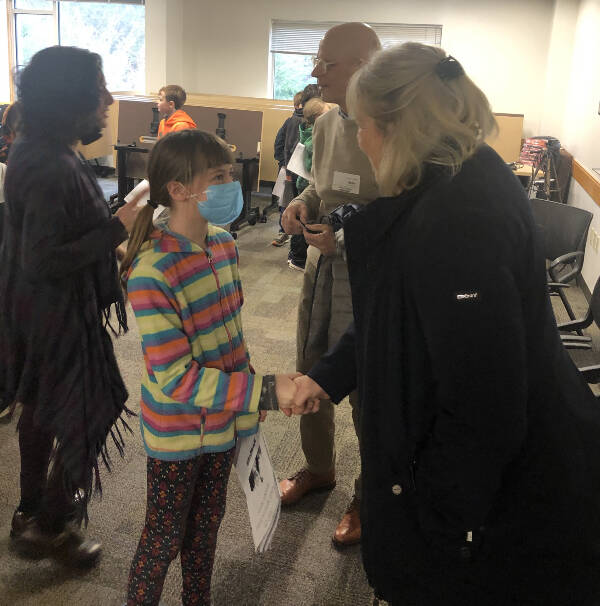Third-grade students at Chautauqua Elementary School (CES) are currently in the midst of exploring what life is like for elders — and learning how to reach across the generational divide to connect with and help seniors on Vashon.
It’s a year-long social activism project, chosen by the 72 third-graders themselves, that in January included a three-week speaker’s series.
The speakers included experts in aging from Vashon to Illinois, who shared some of the joys of aging, but also, discussed the very real issues of ageism, caregiving needs, isolation and others difficulties experienced by seniors.
One installment of the speaker’s series was a lively panel discussion, held on Jan. 18.
The panel was moderated by Mike Kirk, a retired educator who, at the age of 81, is still a substitute teacher at Vashon High School and a volunteer for Vashon Island Fire & Rescue.
Gerie Wilson, a more recently retired teacher at CES, was also part of the panel, as was Diane Brenno, who at age 86, is now known to generations of islanders as “Grammy.”
For years, Brenno led her own “Lunch Club” program at Chautauqua, designed for kids who preferred quiet time, reading and crafts to boisterous outdoor play at recess.
Todd Pearson, who grew up on Vashon in the 1960s, was another speaker.
Nicole Martin, a parent of a third-grader, also joined the panel and spoke about the joys of growing up on Vashon, where her grandparents also lived.
According to third-grade teacher Marjorie Butcher, the majority of current third-grade students do not have grandparents on the island.
Action Network Curriculum
The third-grade project is part of a longstanding social activism and citizenship curriculum, Action Network, that was created by Butcher 23 years ago.
“I started it with first graders in Seattle in 2000, and have done it every year since,” Butcher said. “A few years later, my fourth-grade class came up with a logo and [Action Network’s] tagline — ‘a small voice can change the world.’”
Throughout her teaching career, Butcher said, her students in first through ninth grades have responded enthusiastically to the curriculum.
“Doing something real, that you care about, is meaningful for all of us, young and old,” she said.
At Chautauqua, Butcher’s colleagues Erin Calhoun and Layla Tanner have joined Butcher in incorporating Action Network into their social studies curriculum, connecting all the school’s third-grade students with a common purpose.
Starting last October, the third-graders thought about problems they were aware of, learned about a few of them more in-depth, and brainstormed solutions.
After exploring three initial topics, the students then decided to focus on issues facing elders on Vashon — a choice that Butcher applauded.
“I have found for elementary kids, keeping it local makes it more meaningful,” she said.
Currently, students are in the research phase of the project — which included the three-week speaker’s series in January. Next, the third-graders will move on to design a project they can all work together on throughout the spring.
Also, over the next few months, each student will write letters to a Vashon elder pen pal. Later this spring, the students will meet their pen pals in person and, through a Vashon Artists in Schools grant, be photographed with them by Dawn Steif.
These 72 photographs will be displayed at Pop Pop Bottle Shop and also play in a slide show, before movies, at Vashon Theatre in June.
Elders share insights
But on Jan. 13, they first received the wisdom of Kirk, Brenno, Wilson, Pearson and Martin, who talked about the issues of aging from a local perspective, and how Vashon has changed throughout the years.
Pearson, who still holds the record at Vashon High School for the 100-yard dash, talked about the differences between Vashon when he was a student, and now.
Many third-graders were surprised to hear that on Vashon, there used to be two elementary schools — and north-end kids, who attended Vashon Elementary, didn’t know south-end kids, who attended Burton Elementary.
“When you went to high school, you met these other kids for the first time, and there were fights,” Pearson said.
Pearson also described how the landscape had changed on Vashon.
“When I was a kid, all over Vashon, you could see out: you could see the water, you could see the mountains, and now the trees have gotten so big that it’s hard to see almost anywhere,” he said.
Wilson talked about her own childhood, in New York, and her move across the country to Vashon, but also her delight to return to Chautauqua, where she had taught for 23 years.
“I’m so excited to get back here and see these faces,” she said, with a wide smile.
The panel also identified some things that haven’t changed on Vashon.
Many students nodded in agreement when Wilson said her favorite spot on the island was KVI Beach, with its hot sand in the summer.
“The ferries,” Brenno said. “We all deal with the ferries.”
Groans of agreement erupted from the kids.
The third-graders asked the panel what was difficult about living on Vashon as they’ve gotten older.
“The hardest part about living on Vashon for me is not being around a lot of kids your age — because you guys have a lot of wonder and curiosity and questions and you’re fun to talk to and interesting,” said Wilson.
At the panel discussion, third-grader Agnes Simmons, age 9, met Wilson for the first time — who will be her pen pal in the next phase of the project.
“We both love crafts, so she seems like the right person for me,” Simmons said.


